Retreat
How Can I Make My Hot Tub Water Smell Better

Are you tired of the overwhelming stench that greets you every time you step into your hot tub? Well, fear not! I have the ultimate solution to make your hot tub water smell like a fragrant oasis.
In this article, I will unveil the secrets to banishing unpleasant odors from your hot tub. From identifying the root cause to maintaining proper water chemistry, I will guide you through every step.
Get ready to enjoy a fresh and revitalizing hot tub experience like never before!
Key Takeaways
- Check sanitizer levels and clean or replace the filter to prevent odors and remove contaminants.
- Regularly test and adjust chemical levels, balance pH levels, and use water clarifiers for clean and refreshing hot tub water.
- Maintain recommended pH and calcium hardness levels, clean or replace the filter regularly, and address reduced water flow or cloudy water promptly.
- Use natural remedies like essential oils to freshen the water and create a more enjoyable and therapeutic hot tub experience.
Identifying the Cause of the Odor
I can determine if there’s a specific cause of the odor in my hot tub water. To prevent algae growth and remove chemical residue, it’s essential to identify the underlying cause of the odor.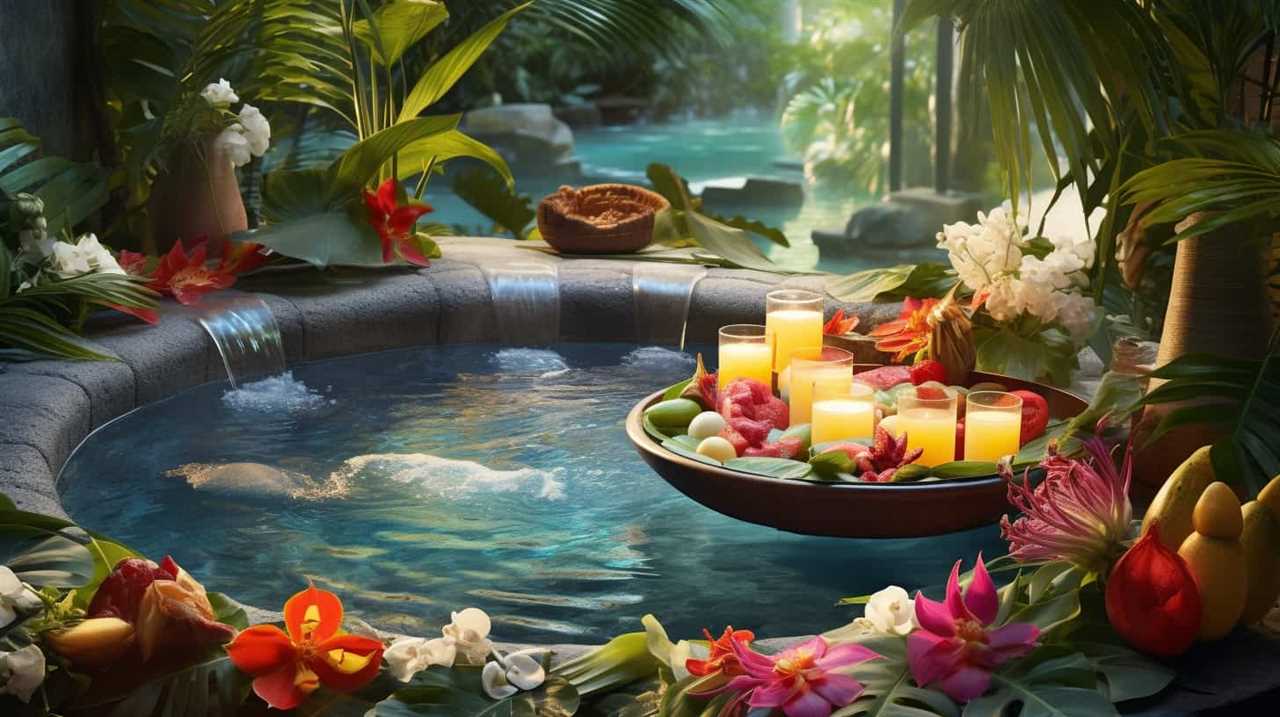
First, I’ll check the sanitizer levels, ensuring they’re within the recommended range. Low sanitizer levels can lead to algae growth, which can cause unpleasant odors.
Next, I’ll inspect the filter and clean or replace it if necessary. A dirty filter can trap contaminants and contribute to foul smells.
Additionally, I’ll test the pH and alkalinity levels to ensure they’re balanced. Imbalanced water chemistry can result in chemical residue, leading to odors.
Maintaining Proper Water Chemistry
To ensure optimal water quality, it’s crucial to regularly test and adjust the chemical levels in my hot tub. Balancing pH levels is one of the most important aspects of maintaining proper water chemistry. The pH level should ideally be between 7.2 and 7.8 to ensure the effectiveness of sanitizers and prevent scale buildup.
If the pH is too high, I can use a pH reducer to bring it down. On the other hand, if the pH is too low, I can use a pH increaser to raise it. Additionally, using water clarifiers can help remove organic and inorganic particles, improving water clarity and reducing odors.
By properly balancing the pH levels and using water clarifiers, I can ensure clean and refreshing hot tub water.
Now, let’s move on to the next section about regular cleaning and sanitization.
Regular Cleaning and Sanitization
Regular cleaning and sanitization are essential for maintaining clean and odor-free hot tub water. Neglecting these tasks can lead to the buildup of bacteria, algae, and other contaminants, resulting in unpleasant smells and potential health risks. To ensure the longevity and enjoyment of your hot tub, here are some key steps to follow:
Preventing Scale Formation: Scale formation can occur due to the high mineral content in the water. To prevent this, regularly test and maintain the pH and calcium hardness levels within the recommended range. Additionally, using a scale control product can help inhibit the buildup of scale on the hot tub surfaces.
Troubleshooting Filter Issues: The filter plays a crucial role in keeping the water clean. It’s important to clean or replace the filter regularly as per the manufacturer’s instructions. If you notice reduced water flow or cloudy water, it could be a sign of a clogged or faulty filter. Address the issue promptly to maintain proper filtration and prevent odors.
Using Natural Remedies to Freshen the Water
Lemon and baking soda are effective natural remedies that can freshen the water in your hot tub. Here are four DIY recipes using essential oils that can help improve the scent of your hot tub water:
Lemon and Lavender: Mix 10 drops of lemon essential oil and 5 drops of lavender essential oil in a small bowl. Add this mixture to your hot tub water to create a refreshing and calming scent.

Peppermint and Eucalyptus: Combine 8 drops of peppermint essential oil and 6 drops of eucalyptus essential oil. Add this mixture to your hot tub water for a rejuvenating and invigorating aroma.
Orange and Tea Tree: Mix 12 drops of orange essential oil and 4 drops of tea tree essential oil. This combination will give your hot tub water a pleasant citrusy scent with antimicrobial properties.
Rosemary and Juniper Berry: Combine 7 drops of rosemary essential oil and 7 drops of juniper berry essential oil. This mixture will provide a refreshing and herbal aroma while also helping to cleanse the water.
Using these DIY recipes with essential oils won’t only freshen the water in your hot tub but also create a more enjoyable and therapeutic experience for you and your guests.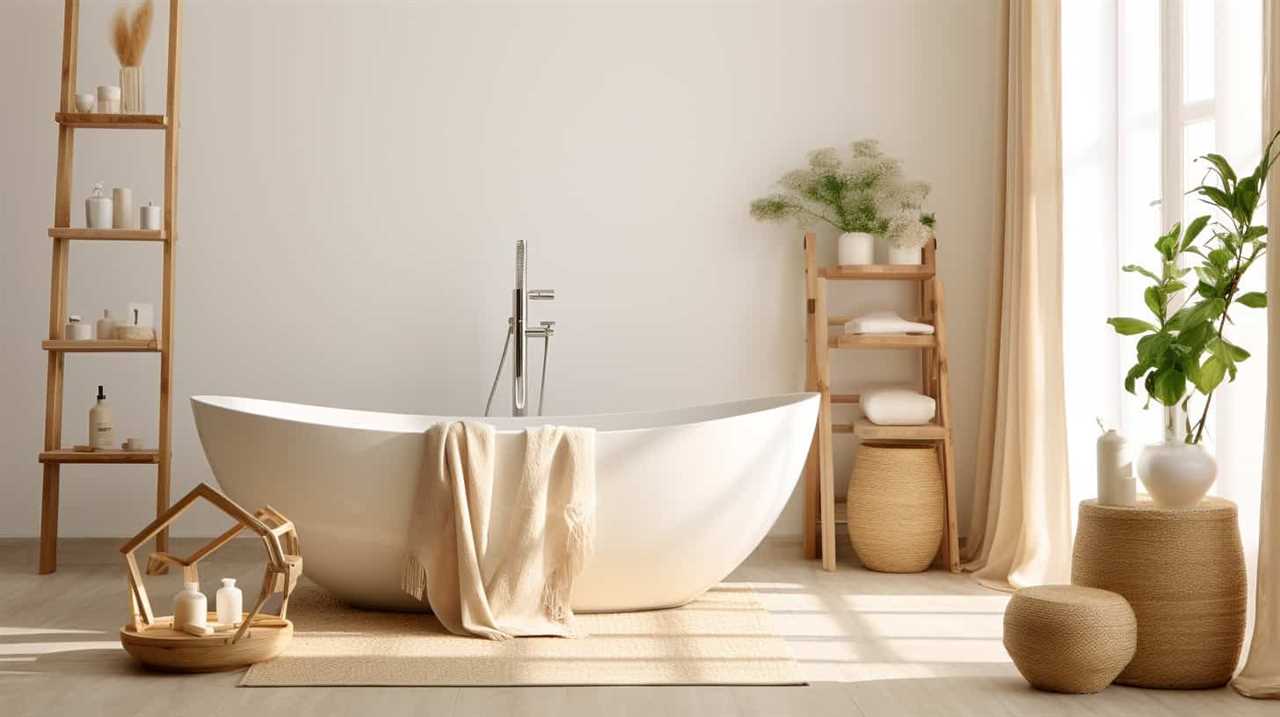
Preventing and Addressing Bacterial Growth
First, I must ensure that I properly sanitize my hot tub to prevent bacterial growth. Bacteria can form a slimy layer called biofilm, which can harbor harmful pathogens.
To prevent biofilm formation, I recommend using a chlorine-based sanitizer or a bromine-based sanitizer. These sanitizers effectively kill bacteria and prevent their growth.
It’s essential to maintain proper pH levels in the hot tub water as well. Controlling pH levels effectively is crucial because high or low pH can create an environment that promotes bacterial growth.
Test the water regularly using test strips or a testing kit and adjust the pH levels accordingly using pH increasers or decreasers.
Frequently Asked Questions
Can I Use Scented Oils or Fragrances in My Hot Tub Water to Make It Smell Better?
Yes, you can use scented oils or fragrances in your hot tub water to make it smell better. However, there are also alternatives such as natural remedies that can be effective in achieving a pleasant scent.
What Should I Do if I Notice a Strong Chlorine Smell in My Hot Tub Water?
If I notice a strong chlorine smell in my hot tub water, I should be aware of the potential health risks and take steps to minimize them. I can naturally reduce the chlorine smell by using baking soda or activated carbon filters.
Are There Any Specific Hot Tub Filters or Chemicals That Can Help Eliminate Odors?
Hot tub filters and certain chemicals can effectively eliminate odors, ensuring a pleasant experience. Additionally, alternative methods like using scented oils or aromatherapy beads can enhance the scent of the water.
How Often Should I Drain and Refill My Hot Tub Water to Maintain a Fresh Smell?
I typically drain and refill my hot tub water every 3-4 months to maintain optimal water quality and a fresh smell. This helps to prevent buildup of bacteria and contaminants that can affect the overall experience.
Can I Use Household Cleaning Products to Clean My Hot Tub and Get Rid of Any Lingering Odors?
I can use natural remedies to make my hot tub water smell better. Regular hot tub maintenance is beneficial for preventing odors and ensuring a clean and enjoyable experience.
Can I Use Hot Tub Water Solutions to Create a Spa Experience at Home?
Yes, you can definitely use hot tub water solutions to create a spa day for wife at home. By adding some essential oils, bath salts, and a few candles, you can transform your hot tub into a relaxing and luxurious spa experience right in your own backyard.
Conclusion
In conclusion, maintaining proper water chemistry and regular cleaning and sanitization are essential for keeping your hot tub water smelling fresh.
Additionally, using natural remedies can help to freshen the water and prevent bacterial growth.
By following these steps, you can enjoy a pleasant and odor-free hot tub experience.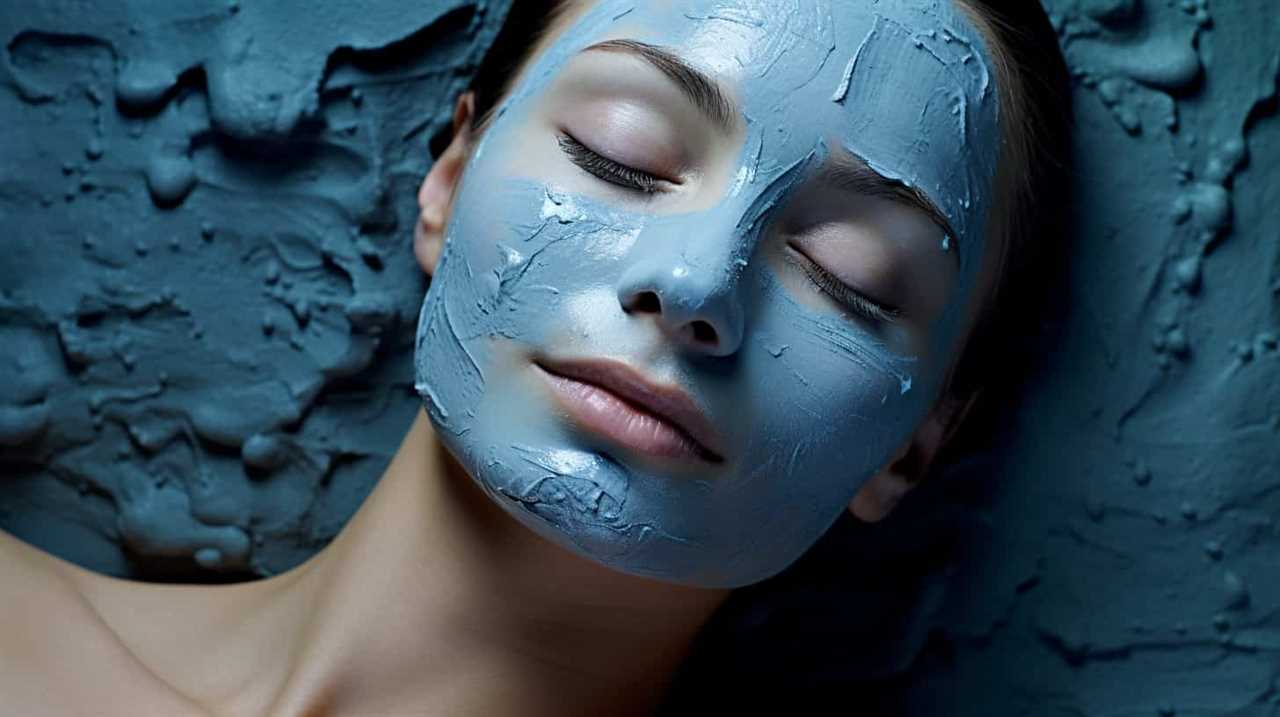
- About the Author
- Latest Posts
Introducing Charles, the Editor in Chief at ByRetreat, whose passion for interior design and editorial excellence elevates every remote workspace to new heights. With his keen eye for detail, impeccable taste, and expertise in design, Charles brings a wealth of knowledge and creativity to the ByRetreat team.
As the Editor in Chief of a renowned lifestyle blog, Charles has honed his skills in curating captivating content and staying up-to-date with the latest trends in interior design. His deep understanding of aesthetics and the power of storytelling through design enables him to create remote workspaces that are not only visually stunning but also rich in personality and meaning.
Spa Design
5 Luxurious Spa Designs by KCO
Discover the captivating allure of KCO Design's five luxurious spa designs, where elegance and sophistication converge to create unparalleled sanctuaries of relaxation.

Let's take a moment to appreciate the understated opulence of KCO Design's five luxurious spa designs. Each spa beckons with an air of refinement and exclusivity that promises a truly indulgent experience.
As we explore these meticulously crafted spaces, we'll uncover the artful blend of comfort and sophistication that sets KCO apart in the world of luxury spa design.
The attention to detail and innovative design elements in these sanctuaries of relaxation invite us to discover a world where pampering meets architectural finesse.
Key Takeaways
- Tranquility and nature-inspired decor for a serene spa experience
- Fusion of beauty services and urban retreat ambiance for a luxurious urban spa
- Elegance through minimalist design and meticulous curation in spa settings
- Comprehensive wellness offerings beyond traditional treatments for holistic well-being
Serene Nature Retreat Spa
Nestled amidst a verdant oasis, the Serene Nature Retreat Spa beckons with its harmonious blend of natural elements and rejuvenating ambiance. As a premier day spa, our focus is on providing a tranquil environment where guests can escape the hustle and bustle of daily life. The design philosophy of the spa revolves around incorporating earthy tones, organic textures, and nature-inspired decor to create a sense of serenity that envelops visitors from the moment they step inside.
Luxurious treatment rooms await our guests, each thoughtfully designed to enhance relaxation and promote holistic wellness. The Serene Nature Retreat Spa prides itself on offering a comprehensive wellness experience that goes beyond traditional spa treatments. From the soothing sounds of flowing water to the gentle rustling of leaves outside, every detail has been carefully curated to transport guests to a state of blissful tranquility.
Come indulge your senses and rejuvenate your mind, body, and soul at our Day Spa oasis.
Urban Oasis Spa
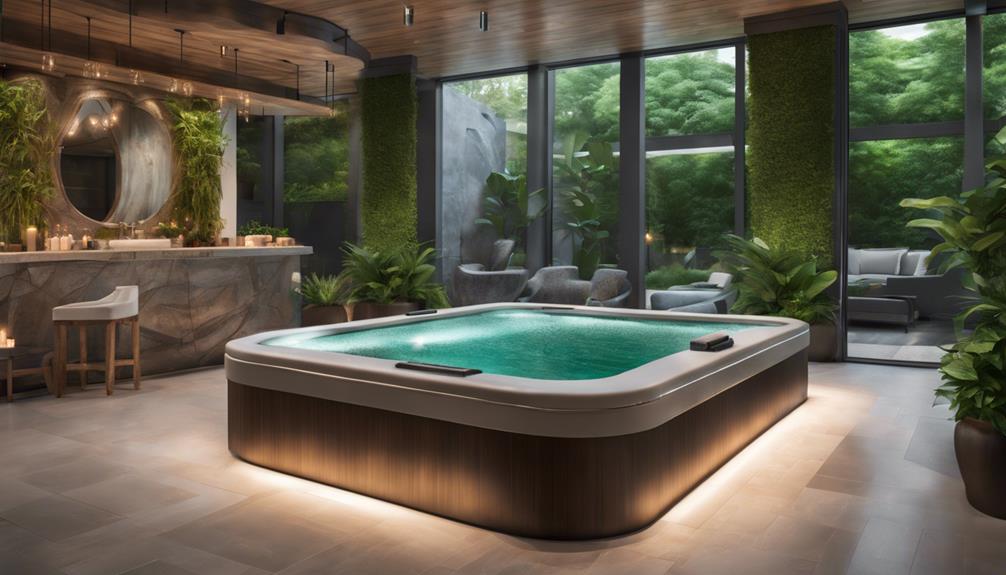
Crafting an urban sanctuary of relaxation and luxury, KCO Design presents the exquisite Urban Oasis Spa, where modern elegance meets tranquil rejuvenation. This innovative spa concept combines upscale urban design with a serene ambiance to offer clients a premium salon experience.
Here are some key features that make Urban Oasis Spa a must-visit destination:
- Chic Salon Environment: The salon area at Urban Oasis Spa exudes sophistication with its sleek design and luxurious furnishings, creating a stylish space for clients to enjoy beauty treatments.
- Cutting-edge Spa Services: Clients can indulge in a range of cutting-edge spa services, from advanced skincare treatments to bespoke hair services, all delivered with expert precision.
- Contemporary Decor Elements: Modern decor elements such as minimalist lighting fixtures and elegant botanical accents elevate the overall ambiance of Urban Oasis Spa.
- Personalized Pampering: The salon professionals at Urban Oasis Spa provide personalized consultations to ensure each client receives bespoke treatments tailored to their needs.
- Urban Retreat Experience: Urban Oasis Spa offers a tranquil retreat in the heart of the city, allowing clients to escape the hustle and bustle and unwind in a luxurious setting.
Minimalist Elegance Spa
Elevating the essence of modern luxury, KCO Design's Minimalist Elegance Spa captivates with its focus on clean lines and serene ambiance, seamlessly blending simplicity with sophistication. Neutral color palettes and natural elements infuse the space with a calming aura, while modern furnishings and minimalist lighting add a contemporary touch, creating a space that exudes luxury and tranquility. Clients stepping into the Minimalist Elegance Spa can expect a haven designed for relaxation and rejuvenation, where every detail has been meticulously curated to provide an experience of unparalleled elegance.
Luxury hair care takes center stage in this minimalist oasis, where clients can indulge in premium treatments amidst the understated yet refined decor. The harmonious blend of minimalism and sophistication ensures that every visit to the Minimalist Elegance Spa is a journey into a world of pure luxury and pampering. With a focus on delivering a serene environment that speaks of modern opulence, this spa design by KCO is a testament to the art of creating a truly luxurious experience.
Zen Garden Sanctuary Spa

The Zen Garden Sanctuary Spa envelops visitors in a serene haven of tranquility and rejuvenation, offering a luxurious escape from the demands of daily life. As we step into this oasis of relaxation, we're greeted by the following:
- A meandering stone pathway, lined with lush greenery and blooming flowers, leading us towards the heart of the spa.
- Soft, ambient music playing in the background, creating a soothing atmosphere that instantly calms the mind.
- Japanese-inspired sliding doors opening up to reveal private treatment rooms adorned with traditional tatami mats and minimalist decor.
- The gentle sound of water trickling from a bamboo fountain, adding a peaceful melody to the air.
- A fragrant aroma of essential oils and incense, subtly infusing the space with a sense of tranquility and zen.
At Zen Garden Sanctuary Spa, every detail is meticulously curated to ensure a blissful experience, where guests can unwind and rejuvenate throughout the day.
Contemporary Wellness Haven
Stepping from the tranquil Zen Garden Sanctuary Spa into the realm of the Contemporary Wellness Haven at KCO Design: Salon and Day Spa, visitors are immersed in a modern oasis of relaxation and rejuvenation. Our design ethos blends sophistication with functionality, creating an ambiance that speaks to the desires of contemporary spa enthusiasts. The sleek lines, minimalist décor, and strategic lighting in our space elevate the overall experience, setting a new standard for luxury in the salon and day spa industry.
At KCO Design: Salon and Day Spa, we prioritize the fusion of top-notch skincare, waxing, and beauty services with a chic and tranquil setting. Our commitment to excellence has earned us a reputation as one of Baltimore's premier salons, renowned for both our exceptional spa designs and services. Clients seeking a premium wellness experience flock to our doors, enticed by the promise of a luxurious haven where every detail is meticulously curated to enhance their well-being and beauty journey.
Frequently Asked Questions
What Are the Average Prices for Treatments and Services at Each of the Spa Designs by Kco?
At each of the spa designs by KCO, our pricing for treatments and services varies based on the luxurious experience and personalized care you desire. Our team ensures you receive exceptional value and indulgence.
Are the Spa Designs by KCO Available for Private Events or Group Bookings?
Are the spa designs by KCO available for private events or group bookings? Absolutely! We cater to your needs, offering exclusive experiences for gatherings of all sizes. Our luxurious spaces are perfect for creating unforgettable moments.
Do Any of the Spa Designs by KCO Offer Specialized Treatments for Specific Health Conditions or Concerns?
Absolutely, some of our spa designs offer specialized treatments for specific health conditions or concerns. We meticulously craft each experience to cater to individual needs, ensuring a rejuvenating and tailored approach to wellness.
Can Guests Customize Their Experience at the Spa Designs by KCO With Add-On Services or Amenities?
Absolutely, guests can fully customize their experience at the spa designs by KCO with a wide array of add-on services and amenities. We pride ourselves on offering a tailored and indulgent spa experience for each individual.
Are There Any Exclusive Partnerships or Collaborations With Luxury Brands at the Spa Designs by Kco?
At our spa, we curate exclusive partnerships with luxury brands to elevate your experience. For instance, we collaborate with a renowned skincare line, offering personalized treatments using their exquisite products to indulge our guests.
Conclusion
In a world of chaos and stress, these luxurious spa designs by KCO offer a sanctuary of serenity and rejuvenation. Each space is a work of art, carefully crafted to transport guests to a realm of pure relaxation and indulgence.
From the tranquil Zen Garden Sanctuary to the contemporary Wellness Haven, these designs truly embody the essence of luxury and wellness. Step into a world where every detail is a masterpiece, and let your worries melt away in pure bliss.
- About the Author
- Latest Posts
Introducing Ron, the home decor aficionado at ByRetreat, whose passion for creating beautiful and inviting spaces is at the heart of his work. With his deep knowledge of home decor and his innate sense of style, Ron brings a wealth of expertise and a keen eye for detail to the ByRetreat team.
Ron’s love for home decor goes beyond aesthetics; he understands that our surroundings play a significant role in our overall well-being and productivity. With this in mind, Ron is dedicated to transforming remote workspaces into havens of comfort, functionality, and beauty.
Spa Design
Creating a Luxurious Spa Backyard Design
Discover the blissful world of opulent spa backyard design, where tranquility meets extravagance, promising a haven of relaxation and indulgence.

As we explore the realm of luxurious spa backyard design, we stumble upon a realm of tranquility and indulgence where every element is meticulously curated for ultimate relaxation.
Picture this – a serene oasis right in your backyard, where the stresses of the day melt away effortlessly.
But how does one transform a simple outdoor space into a lavish spa retreat that rivals those of high-end resorts?
Let's uncover the secrets to crafting a truly opulent sanctuary where you can unwind and rejuvenate in style.
Key Takeaways
- Incorporate hot tubs, ambient lighting, and comfortable seating for a luxurious spa experience.
- Enhance the ambiance with decorative fountains, lush greenery, and colorful flowers.
- Create cozy spaces with plush seating, string lights, and a fire pit for warmth.
- Ensure privacy and relaxation through wooden structures, privacy screens, and trellises.
Spa Backyard Design Elements
In crafting our luxurious spa backyard design, we infuse it with a symphony of elements that tantalize the senses and transport us to a sanctuary of relaxation and rejuvenation. Our outdoor space is adorned with the finest features, including soothing hot tubs that beckon us to unwind after a long day. To ensure privacy, we strategically place privacy screens around the spa area, offering a secluded oasis where we can fully immerse ourselves in the natural beauty that surrounds us.
Ambient lighting casts a gentle glow, creating a serene ambiance that invites us to linger and enjoy the peaceful atmosphere. Comfortable seating provides the perfect spot to lounge and soak in the tranquility of our spa retreat. Water elements such as fountains and waterfalls add a touch of elegance and tranquility to the space, further enhancing the overall sense of relaxation.
For those sunny days, shading options like pergolas or umbrellas offer protection from harsh UV rays, allowing us to bask in the beauty of our outdoor sanctuary without worry. With these elements harmoniously combined, our spa backyard design is a true haven for rest and rejuvenation.
Water Features and Plantings
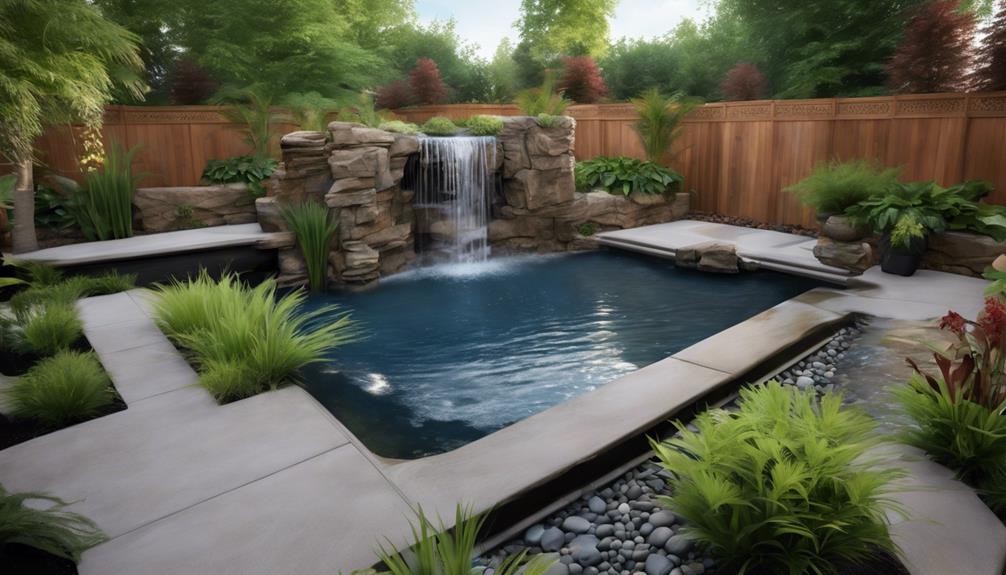
As we continue to shape our luxurious spa backyard design, the integration of captivating water features and vibrant plantings emerges as a pivotal element in creating a sensory oasis of tranquility and natural beauty. Incorporating water features like decorative fountains or soothing ponds adds a touch of elegance and relaxation to the space. Picture a graceful fountain gently bubbling in the corner, its soothing sounds harmonizing with the rustling of leaves in the breeze.
Surrounding the spa with lush greenery, colorful flowers, and fragrant herbs enhances the overall ambiance, appealing to all senses. Imagine vibrant blooms bursting with hues of pink, purple, and white, their sweet scents wafting through the air, inviting you to unwind and breathe in the tranquility of nature. The trickling water from the features creates a serene soundtrack, drowning out the noise of the outside world and enveloping you in a cocoon of peace.
Strategic plantings not only provide privacy and seclusion but also contribute to the beauty of the space, ensuring that every corner exudes luxury and comfort.
Cozy Seating and Lighting
Nestling ourselves into the lap of comfort, we cocoon the spa backyard with cozy seating options and soft, ambient lighting fixtures to elevate our relaxation experience. Plush lounge chairs beckon us to unwind, while hammocks sway gently in the breeze, offering a serene spot for contemplation. The strategic placement of these seating options encourages intimate conversations and social gatherings, fostering a sense of community within the tranquil space.
| Seating Options | Lighting Fixtures | Natural Elements |
|---|---|---|
| Plush lounge chairs | String lights | Candles |
| Hammocks | Lanterns | Torches |
| Outdoor sofas | Dimmable lamps | Fire pit |
Privacy and Relaxation Tips

Creating a secluded sanctuary for ultimate relaxation and privacy in your spa backyard involves strategic placement of features and structures to enhance your tranquil oasis. Here are three privacy and relaxation tips to help you create the perfect spa retreat:
- Privacy Structure: Build a wooden privacy structure around your hot tub to create a cozy atmosphere and shield it from prying eyes. This enclosed space will make you feel like you're in your private sanctuary, away from the outside world.
- Arbor: Enhance privacy and add a touch of elegance to your spa oasis by installing an arbor over the hot tub area. The arbor not only provides shade and seclusion but also adds a charming aesthetic to your backyard design, perfect for creating a soothing ambiance.
- Privacy Screens: Incorporate privacy screens, trellises, or pergolas around your spa area to further enhance the sense of seclusion and tranquility. These structures not only offer privacy but also create a serene environment where you can unwind and rejuvenate in peace.
Maintenance and Enjoyment Tips
How can we enhance our spa experience through both maintenance and enjoyment practices? Ensuring proper maintenance is essential for a luxurious spa experience. This involves regular water care and component upkeep following the manufacturer's guidelines to prolong the lifespan of your spa. Advanced control panels allow for customization, letting you adjust jets, lighting, and sound systems to tailor your spa experience to your preferences. When it comes to installation, seeking professional assistance for electrical and plumbing requirements is crucial for safety and optimal setup.
To further elevate your spa enjoyment, incorporate relaxation techniques such as deep breathing exercises or mindfulness practices while soaking in the soothing waters. Enhance the ambiance with calming music and aromatherapy using essential oils known for their relaxing properties. By combining proper maintenance with relaxation techniques, you can create a spa oasis in your backyard that promotes both physical well-being and mental relaxation.
| Maintenance | Enjoyment |
|---|---|
| Regular water care | Relaxation techniques |
| Component upkeep | Soothing music |
| Control panels | Aromatherapy |
| Professional assistance | Mindfulness practices |
Frequently Asked Questions
How to Design a Backyard With a Hot Tub?
So, we position the hot tub amidst lush greenery and water features for a serene vibe. Surround it with privacy screens, add ambient lighting, comfy seating, and water elements. It creates a luxurious spa-like retreat in our backyard.
How Do I Make My Hot Tub Look Classy?
To make our hot tub look classy, we choose sleek, modern design elements like stainless steel jets and LED lighting. High-quality materials such as teak wood and natural stone elevate the appearance. Adding a custom-built pergola or gazebo enhances the chic setting.
How Much Does It Cost to Build an Outdoor Spa?
Building an outdoor spa can range from $3,000 to $30,000+. Costs vary based on size, features, and materials. Factors like spa type, installation needs, lighting, and landscaping influence prices. Luxury options with customization can go beyond $20,000.
How Do You Build an Outdoor Spa?
We start by selecting a suitable location, ensuring utility access. The spa's size and shape must fit well and complement our backyard. A sturdy foundation, plumbing, and electrical connections are crucial. Insulation and sealing maintain energy efficiency and protect from elements.
Conclusion
In creating a luxurious spa backyard design, we must consider the perfect balance of water features, plantings, cozy seating, and lighting.
Privacy and relaxation tips are essential for a tranquil retreat. By incorporating maintenance and enjoyment tips, we can ensure our spa oasis remains a haven of relaxation for years to come.
Let's immerse ourselves in the soothing ambiance of our spa backyard and indulge in moments of pure bliss and rejuvenation.
- About the Author
- Latest Posts
Introducing Ron, the home decor aficionado at ByRetreat, whose passion for creating beautiful and inviting spaces is at the heart of his work. With his deep knowledge of home decor and his innate sense of style, Ron brings a wealth of expertise and a keen eye for detail to the ByRetreat team.
Ron’s love for home decor goes beyond aesthetics; he understands that our surroundings play a significant role in our overall well-being and productivity. With this in mind, Ron is dedicated to transforming remote workspaces into havens of comfort, functionality, and beauty.
Spa Design
Creating a Stylish Spa Uniform Design Guide
Unveil the secrets to crafting chic spa uniforms that redefine elegance and professionalism – discover the ultimate guide here!
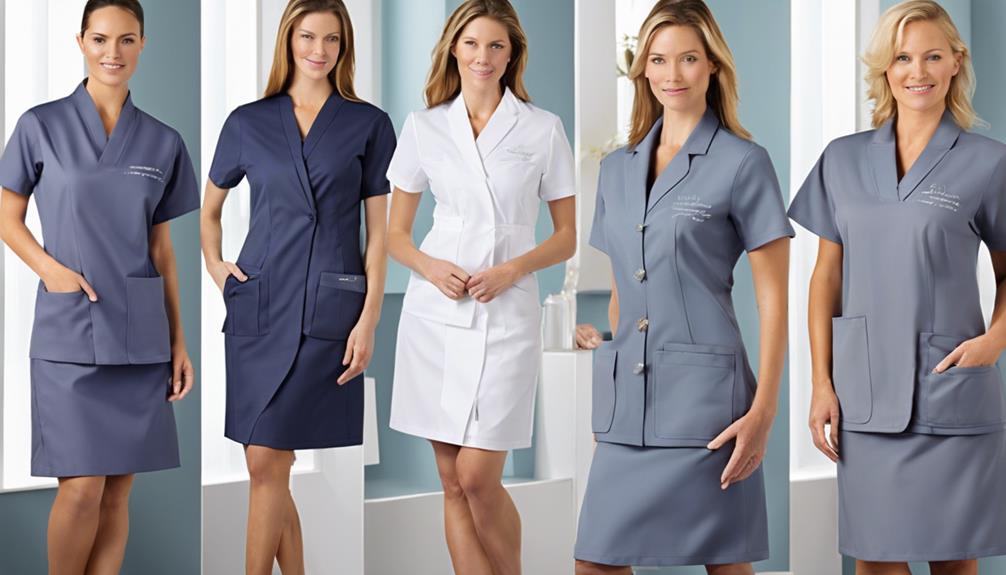
Let's face it – spa uniforms are often overlooked in the world of fashion, but why settle for the mundane when you can elevate your spa's style game effortlessly?
With a meticulous focus on fabric choices, color schemes, trendy accents, and practical functionalities, the art of crafting a stylish spa uniform design guide opens up a realm of possibilities.
But what key elements truly define a standout spa uniform design? Let's explore how attention to detail and a touch of creativity can transform the way spa professionals present themselves, setting a new standard in the industry.
Key Takeaways
- Prioritize comfort and breathability with materials like Bi-Stretch and cotton.
- Infuse modern flair with bold colors and subtle pops for sophistication.
- Incorporate unique style elements like interesting necklines and stylish buttoning.
- Opt for functional features like moisture-wicking fabrics and multiple pockets for convenience.
Fabric Selection
When crafting stylish spa uniforms, we prioritize fabric selection to ensure comfort, breathability, and durability for spa professionals in diverse environments. Our goal is to create uniforms that not only look great but also feel great to wear throughout long shifts.
For spa environments, where professionals are constantly on the move, we opt for materials like Bi-Stretch, Trevor, polyester, nylon, or polyurethane that offer flexibility and ease of movement. In warmer climates, breathability becomes crucial, leading us to choose fabrics like cotton and linen that help regulate body temperature and wick away moisture.
The absorbent properties of cotton, which can absorb up to 27 times its weight in moisture, and linen, which can absorb up to 20 times its weight, make them ideal choices for spa uniforms. Additionally, we focus on lightweight yet durable materials that can withstand the demands of daily wear in a spa setting while providing the functionality and comfort spa professionals need to excel in their roles.
Color Palette
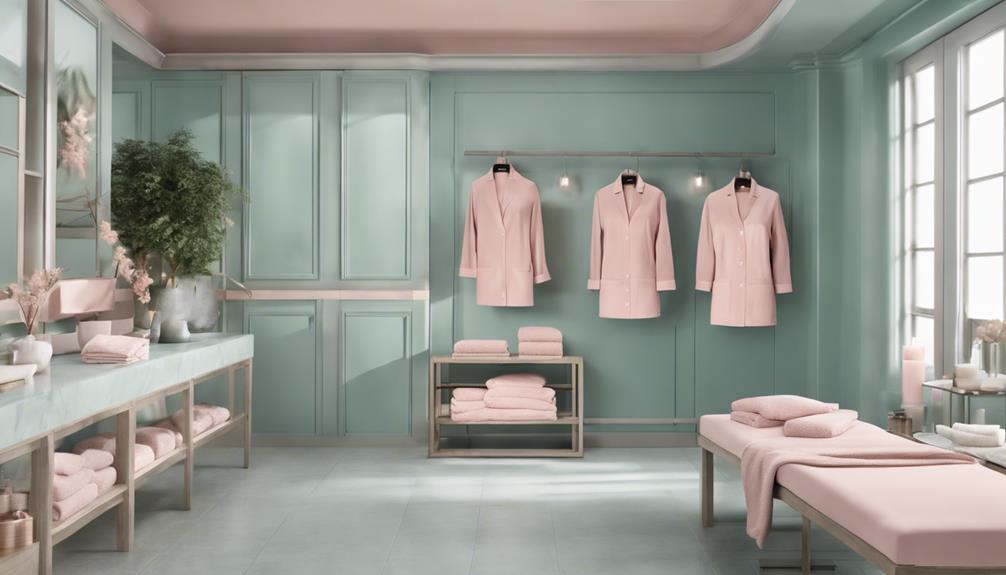
Exploring a vibrant and chic color palette is essential to infuse modern flair into spa uniforms, elevating their aesthetic appeal and making a bold statement in the beauty industry. When selecting colors for your spa uniforms, consider opting for bold and fashionable hues like red or cobalt blue to ensure your staff stands out. These primary colors are not only on-trend but also exude a contemporary and stylish look that resonates with clients seeking a cutting-edge spa experience. To add a touch of sophistication, incorporate subtle pops of color, such as a bright trim on a black tunic, which can elevate the overall design. Experimenting with different color combinations, as suggested by industry expert Noel Asmar, allows you to create unique and eye-catching effects that set your spa uniforms apart. Use color strategically to either make a dramatic statement or add a subtle touch, enhancing the appeal of your beauty uniforms and reinforcing your brand's image.
| Bold Red | Cobalt Blue | Bright Trim |
|---|---|---|
| Modern | Fashionable | Sophisticated |
| Trendy | Eye-catching | Unique |
Style Elements
To infuse a touch of elegance and sophistication into spa uniforms, we focus on incorporating captivating style elements that elevate the overall aesthetic appeal and create a lasting impression.
When it comes to designing spa tunics, consider incorporating interesting necklines like square or V-neck designs to add a modern twist. Experiment with wraps, ruffles, or asymmetrical elements for a unique and chic look that sets your spa uniform apart. These asymmetrical details can create a dynamic and eye-catching silhouette that exudes trendiness.
Moreover, focusing on small yet impactful details such as stylish buttoning can elevate the overall design, making it memorable and fashionable. To further enhance the visual appeal, opt for contrasting materials and colors that create a striking effect.
Functional Features

Incorporating moisture-wicking fabrics in spa uniforms ensures comfort and functionality during extended shifts. When it comes to functional features, spa professionals require garments that not only look stylish but also enhance their performance. Here are three key elements to consider for spa uniform design:
- Breathable Fabrics: Opt for materials that promote airflow and allow the skin to breathe, keeping spa professionals cool and comfortable throughout the day. Breathable fabrics help in regulating body temperature, preventing overheating during demanding treatments.
- Multiple Pockets: Designs with multiple pockets provide convenient storage for essential tools and products, ensuring that spa professionals have easy access to everything they need without disrupting their workflow. This feature adds practicality to the uniform, allowing for efficient service delivery.
- Flexibility with Side Slits: Tunics with side slits offer ease of movement and flexibility, allowing spa professionals to perform treatments with agility and comfort. The side slits not only enhance mobility but also add a touch of modernity to the uniform design.
Branding and Accessories
Let's elevate the allure and professionalism of spa uniforms through strategic branding and chic accessories that embody the essence of sophistication and expertise. Professional accessories are essential in creating a cohesive and polished look for beauty professionals. By incorporating logo badges, aesthetic buttons, and personalized jewelry, spa uniforms can exude a sense of identity and professionalism that aligns with the overall brand image and interior decor. These accessories not only add a touch of individuality but also serve as a representation of expertise and skills, contributing to a professional appearance that instills confidence in clients.
To visualize the impact of professional accessories, consider the following table:
| Accessory Type | Description |
|---|---|
| Logo Badges | Enhance identity and professionalism |
| Aesthetic Buttons | Add a touch of sophistication |
| Personalized Jewelry | Reflect individual style |
| Necklaces/Bracelets | Infuse uniqueness into the uniform |
Incorporating these elements into spa uniforms elevates the overall aesthetic and expert look, setting a high standard for the industry.
Frequently Asked Questions
What Is the Best Material for a Spa Uniform?
For a spa uniform, the best material combines comfort and durability. Think soft linen blends for breathability and Bi-Stretch or polyester for flexibility. Prioritize fabrics like cotton or linen for warm climates' absorbent properties. Quality matters.
How to Design My Uniform?
Let's infuse your uniform design with luxurious linen blends for breathability. Add flair with unique necklines and button styles. Opt for modern square or V-neck tunics that flatter all body types. Experiment with wraps, ruffles, and asymmetry for trendy spa uniforms.
Conclusion
In the end, we thought we'd it all – the perfect fabrics, the trendiest colors, the most stylish designs.
But as we strutted in our spa uniforms, we realized something was missing. Maybe it was the unexpected pop of neon or the quirky accessory we forgot.
Sometimes, perfection lies in imperfection, and it's the little quirks that truly make us stand out.
So, here's to embracing the unexpected and finding beauty in the flaws.
- About the Author
- Latest Posts
Introducing Ron, the home decor aficionado at ByRetreat, whose passion for creating beautiful and inviting spaces is at the heart of his work. With his deep knowledge of home decor and his innate sense of style, Ron brings a wealth of expertise and a keen eye for detail to the ByRetreat team.
Ron’s love for home decor goes beyond aesthetics; he understands that our surroundings play a significant role in our overall well-being and productivity. With this in mind, Ron is dedicated to transforming remote workspaces into havens of comfort, functionality, and beauty.
-
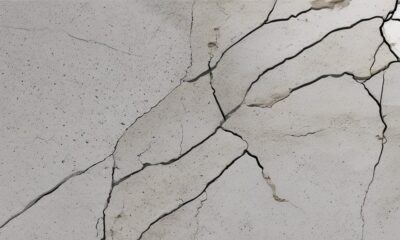
 Vetted5 days ago
Vetted5 days ago15 Best Fillers for Concrete Cracks – Expert Recommendations and Reviews
-

 Vetted7 days ago
Vetted7 days ago15 Best Plants for Large Pots to Transform Your Outdoor Space
-

 Vetted6 days ago
Vetted6 days ago15 Best Fairy Lights to Transform Your Space With Magical Illumination
-

 Vetted1 week ago
Vetted1 week ago15 Best Folding Beds for Small Spaces – Space-Saving Solutions for Comfort and Convenience
-

 Vetted1 week ago
Vetted1 week ago15 Best Waterproof Flooring Options for Your Bathroom – Ultimate Guide & Reviews
-

 Vetted2 weeks ago
Vetted2 weeks ago15 Best Grocery Carts to Make Shopping a Breeze
-

 Vetted21 hours ago
Vetted21 hours ago15 Best Subfloor Options for Your Basement Renovation – Ultimate Guide
-
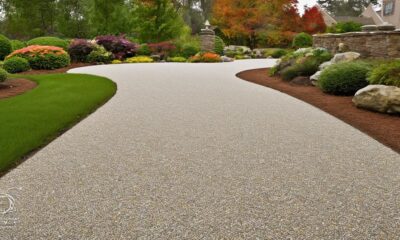
 Vetted3 weeks ago
Vetted3 weeks ago15 Best Gravel for Driveway: The Ultimate Guide for a Durable and Stunning Entrance


























